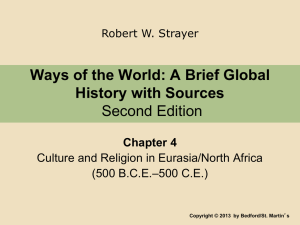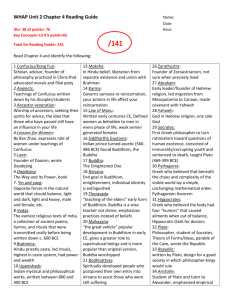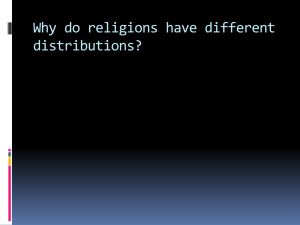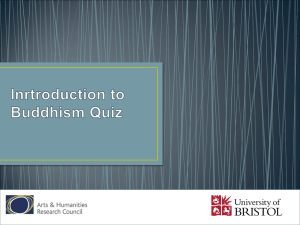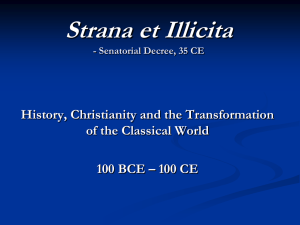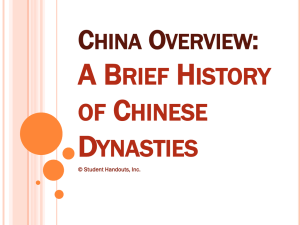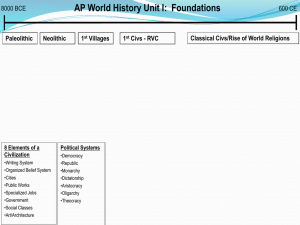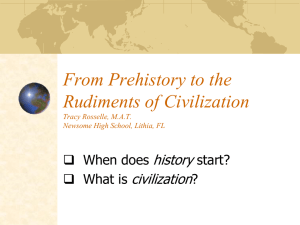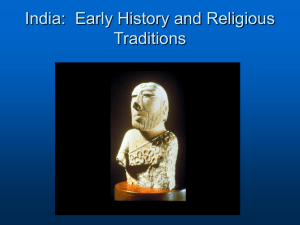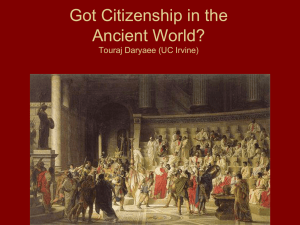Ways of the World
advertisement
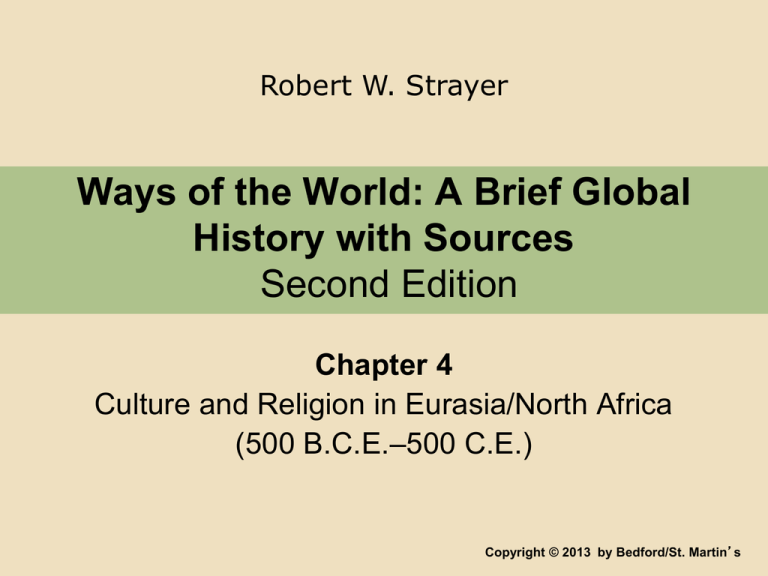
Robert W. Strayer Ways of the World: A Brief Global History with Sources Second Edition Chapter 4 Culture and Religion in Eurasia/North Africa (500 B.C.E.–500 C.E.) Copyright © 2013 by Bedford/St. Martin’s I. China and the Search for Order A. The Legalist Answer 1. High rewards, heavy punishments 2. Qin Shihuangdi Zhou used the Mandate of Heaven to justify them overthrowing the Shang 500 BCE China no longer united 403-221BCE Age of warring states Legalism – China’s solution was in rule of law – strictly enforced with harsh punishments Legalist felt people were stupid and short sighted Only leadership could take care of the country’s long term needs Promote farmers and soldiers and suppress merchants, aristocrats and scholars Shihuangdi used Legalism when he united China. The Qin dynasty did not last long Future dynasties - use the teachings of Confucius I. China and the Search for Order B. The Confucian Answer 1. 2. 3. 4. 5. 6. Confucius, Analects, & Confucianism Moral example of superiors Unequal relationships governed by ren Education and state bureaucracy Filial piety and gender expectations Secular Confucius (551-479 BCE) solve China’s problems Teaching -profound effect on Chinese history Moral leadership would lead to social harmony Father superior to son Husband to wife Oldest brother to youngest brother Ruler to the subject If the superior acted correctly- the inferior would be motivated to do the same Human heartedness, benevolence, goodness, nobility of heart – ren Education important and key to moral betterment Language, literature, philosophy, and ethics Improvement requires personal reflection Ancestor veneration – visiting graves, offerings, shrines Filial piety – honoring of one’s ancestors, parents Ban Zhao – Let women yield to others, fear, humble and guard chastity, wash and scrub, sew and weave, not gossip, prepare wine and food for guests He also called for education for young girls – so they could better serve their husbands Boy’s education would help them learn to control their wives wen referred to qualities of rationality, scholarship, literary and artistic ability wu focused physical and martial achievement Superior men eligible for civil service exam, political office = high prestige Soldiers and merchants lower status Emperors should keep taxes low administer justice and provides for the needs of the people / Those who failed would lose the mandate of heaven I. China and the Search for Order C. The Daoist Answer 1. 2. 3. 4. 5. Laozi’s Daodejing and Zhuangzi Withdrawal into nature Spontaneous natural behavior not rigid education Dao (“The Way”) Contradict or complement Confucianism? Daoism - Associated with legendary figure Laozi Daoists ridiculed the importance of education and striving for moral improvement Encouraged behavior that was spontaneous and individualistic Dao – ways of nature – all life comes from it and it wraps everything with love Daoism – withdraw from the world and social activism, disengage from public life, and align self with nature Daoism -compliments Confucianism – yin and yang II. Cultural Traditions of Classical India A. South Asian Religion: From Ritual Sacrifice to Philosophical Speculation 1. Vedas (1500–600 B.C.E.), Brahmins, and rituals 2. Upanishads (800–400 B.C.E.) 3. Atman and Brahman India - Hinduism Vedas – sacred texts – a collection of hymns and poems and rituals and written in Sanskrit around 600 BCE Suggested a patriarchal society but afforded upper class women greater opportunities Participated in religious sacrifices Allowed scholarship and religious debate Sometimes marry a man they wanted Brahmins – priests performed sacrifices and rituals and gained great power and wealth Upanishads 800-400 BCE – composed by different thinkers - new concepts Brahman – World Soul – the final and ultimate reality Atman or individual soul is a part of Brahman II. Cultural Traditions of Classical India A. South Asian Religion: From Ritual Sacrifice to Philosophical Speculation 4. Samsara, moksha, and karma 5. Gender and the Laws of Manu 6. Cults and deities as different paths Moksha - one strives to find union with Brahman Reincarnation – samsara – rebirth Law of Karma – a person’s action in life Caste system – ranked social structure and each has special duties 500 BCE- 500 CE the second wave-Women seen as unclean below the navel Not allowed to learn the Vedas, excluded from public rituals Law of Manu All embryos were male but weak semen caused female babies Advocated child marriages for girls to men much older Wife should serve her husband like a god Declared in childhood a female is subject to her father, in youth to her husband and after his death to her sons Sexual pleasure a goal for both men and women Kama sutra – sexual techniques II. Cultural Traditions of Classical India B. The Buddhist Challenge 1. Siddhartha Gautama (ca. 566–ca. 486 B.C.E.) 2. The Buddha’s teachings and nirvana 3. Relationship to Hinduism Siddhartha Gautama 566-486 BCE he was a prince in India 6 year quest – he finally gained enlightenment He gained followers who called him Buddha (the enlightened one) Taught people should lead a moral life / meditation One who followed the path of Buddha could achieve enlightenment (nirvana) Enlightened person was free of hate, greed and have love for all beings Rejected - The authority of Brahmins, Caste system II. Cultural Traditions of Classical India B. The Buddhist Challenge 4. 5. 6. 7. Restrictions and opportunities for women Popular appeal Theravada Mahayana’s bodhisattvas Buddhism still practices the patriarchy system Buddha finally gave in an allowed women to become nuns but they were still subordinate to men Buddhism spread – appealed to lower classes taught in local language (Pali) Transformed by Common Era Mahayanna (Great Vehicle) Buddhism became a religion of salvation Buddha became godlike and the religion supported the concept of heaven and hell Acts of piety, devotion and contributing to the monastery could lead to salvation Buddhism eventually declined in India but spread to other areas The growth of a new form of Hinduism was part of the reason for this decline New Hinduism Without the elaborate sacrifices Mahabharata and Ramayana – epic poems II. Cultural Traditions of Classical India C. Hinduism as a Religion of Duty and Devotion 1. Mahabharata, Bhagavad-Gita, and Ramayana 2. Bhakti 3. Buddhism absorbed back into Hinduism III. Toward Monotheism: The Search for God in the Middle East A. Zoroastrianism 1. Zarathustra (seventh to sixth century B.C.E.) 2. Persian state support, Achaemenid Dynasty (558– 330 B.C.E.) 3. Ahura Mazda versus Angra Mainyu 4. Human free will, struggle of good versus evil, a savior, and judgment day Zoroastrianism Persian Empire Prophet Zarathustra (Zoroaster to Greeks) 6th or 7th century BCE Single god Ahura Mazda ruled the world source of truth and light and goodness was in a constant struggle with evil god would win aided by a savior and restore the world to purity and peace Day of Judgment – people who were good would go to eternal paradise – those who were evil faced eternal punishment Religion spread – Egypt, Mesopotamia, and Anatolia Alexander the Great - Greeks ruled Seleucid dynasty 330-155 BCE - spelled disaster Religion survived and grew again during Parthian dynasty 247-224 CE and the Sassanid dynasty 224-651 CE The religion finally dies out with the arrival of Islam Small group fled to India known as Parsis their religion continues to present time Some concepts of Zoroastrianism / found in Judaism and later to Christianity and Islam III. Toward Monotheism: The Search for God in the Middle East B. Judaism 1. Migrations and exiles of a small Hebrew community 2. One exclusive and jealous god 3. Loyalty to Yahweh and obedience to his laws Judaism According to Hebrews texts they migrated from Mesopotamia to Canaan led by Abraham Some went to Egypt where they were enslaved They eventually escape and join their kinfolk in Palestine This was an area dominated by Assyria, Babylon and Persia Lived in tiny Hebrew communities Conquered by Assyria 722 BCE many were deported to distant lands 586 BCE Judah /Babylon control and elite put in exile Jews called their God Yahweh – a powerful and jealous God “Thou shalt have no other gods before me” Jews continued to pray to other gods Prophets would push the people to turn away from other gods Eventually the one God theory won out Jews have a covenant with God / chosen people Sacred text – Torah Yahweh transformed from a God of War to a God of compassion Foundation of Christianity and Islam IV. The Cultural Tradition of Classical Greece: The Search for a Rational Order A. The Greek Way of Knowing 1. Questions, not answers 2. Socrates (469–399 B.C.E.), Plato (429–348 B.C.E.), and Aristotle (384–322 B.C.E.) 3. Rational and non-religious analysis of the world B. The Greek Legacy 1. Alexander the Great, Rome, and the Academy in Athens 2. The loss and recovery of Greece in Europe 3. Greek learning in the Islamic world Cultural traditions of Classical Greece Mount Olympus Home of the gods They had human characteristics Greeks develop a way of thinking Greek Rationalism 600-300 BCE Emphasis on argument, logic, and questioning Socrates 469-399 BCE Philosopher –Critical of Democracy Executed for corrupting the youth Democritus – atoms form matter Pythagoras – formula to solve the right triangle Hippocrates – doctors should care and heal Herodotus –historian /Persian Wars Plato – 429-348 BCE Society should be ruled by highly educated people led by a philosopher king Aristotle 384-322 BCE A student of Plato He wrote about – logic, physics, astronomy, and weather V. The Birth of Christianity… with Buddhist Comparisons A. The Lives of the Founders 1. Encounter with a higher level of reality 2. Messages of love 3. Jesus’ miracles and dangerous social critique Christianity compared to Buddhism Jesus – lower class family / Buddha from wealth class Both were teachers of wisdom Both taught love of others Jesus believed in a god who gave miracles and Buddha did not believe in this Jesus spoke against Roman rule and was executed/ Buddha lived to old age V. The Birth of Christianity… with Buddhist Comparisons B. The Spread of New Religions 1. 2. 3. 4. 5. New religions after their deaths Paul (10–65 C.E.) Lower social classes and women Non-European Christianity Christianity as a Roman religion Buddha and Jesus did not attempt to form new religions Mahayana Buddhism – Buddha became a deity Followers of Jesus Paul, John etc. -saw him as the son of God Christianity -transformation to a world religion starts with Paul 10-65 CE He became a missionary and founded small Christian communities Women should subject to men – the husband is the head of the wife Jesus Mother Mary became a focus of devotion Religion spread very slowly Armenia adopted as state religion Orthodox Christianity took hold in Constantinople First 3 centuries Common Era – Christians face persecution Constantine 4th century – He converted to Christianity – Religion spreads faster New rulers use Christianity as a way to hold their kingdoms together Christian religion spreads and develops a hierarchy Patriarchs, bishops, and priests
